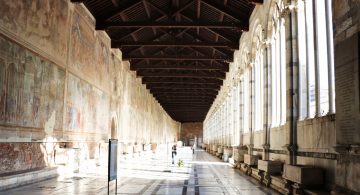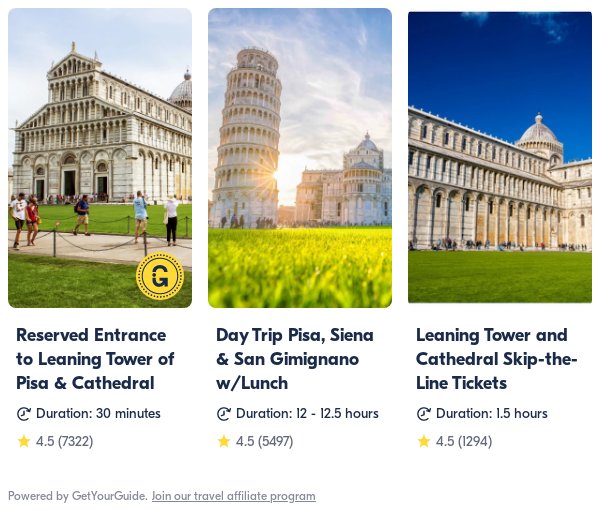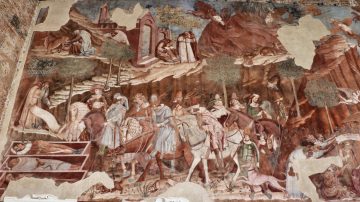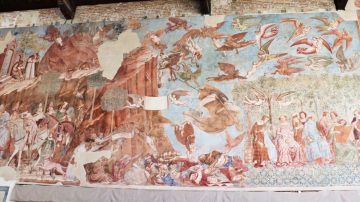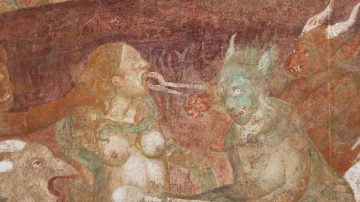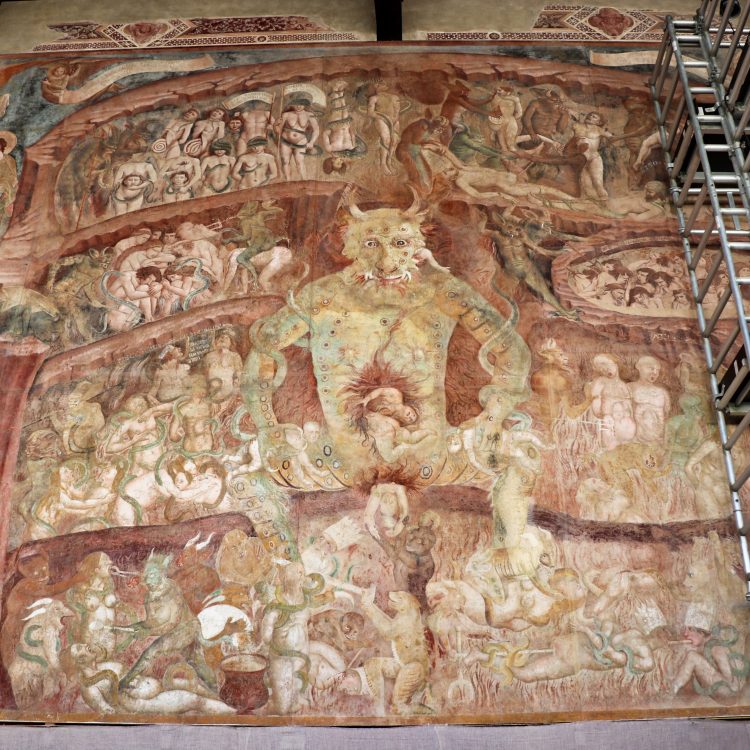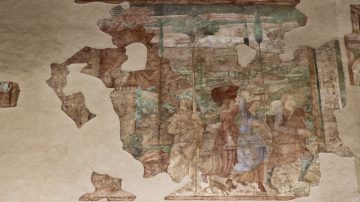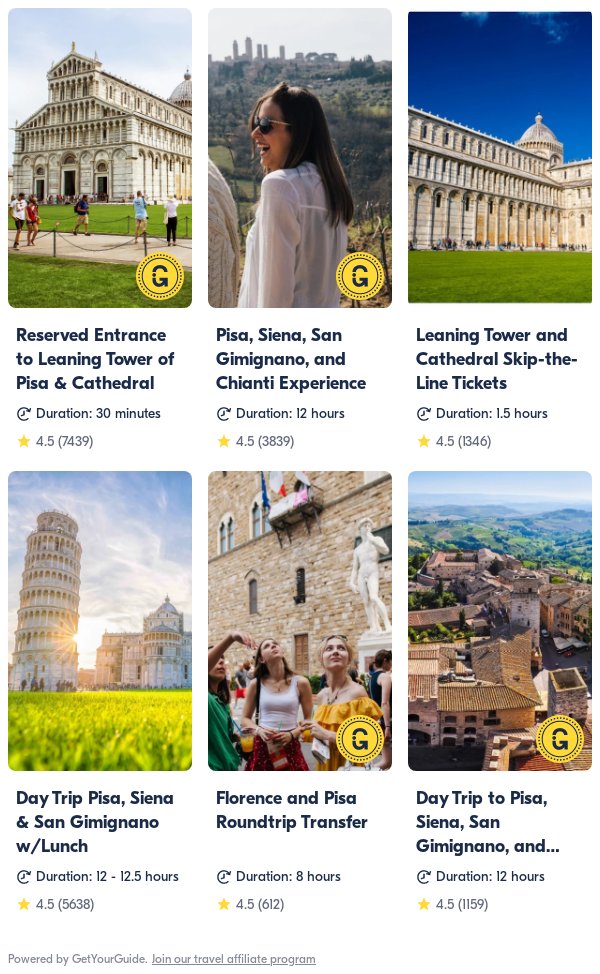The gothic arcades of the Camposanto Cemetery in Pisa are decorated with some of the finest Renaissance frescoes in Italy.
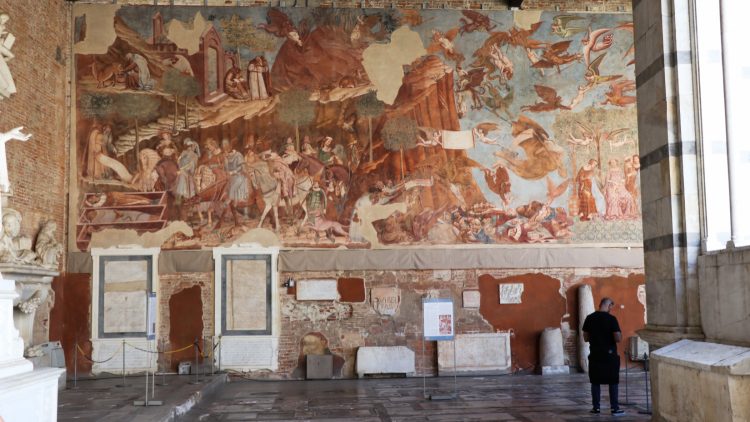
Despite having a large collection of sarcophagi, the Camposanto Cemetery next to the marble Cathedral of Pisa is mostly not visited for graves but rather for its collection of Renaissance frescoes. For centuries the Camposanto, rather than the famous leaning tower, was the main attraction for visitors traveling to Pisa.
Camposanto Cemetery in Pisa
The Camposanto Cemetery is the youngest of the major monuments on Pisa’s cathedral square. In contrast to the Duomo (cathedral), the campanile (leaning tower), and the baptistry, the cemetery is Gothic rather than Romanesque in style. Work started in 1278 but dragged on for over a century. The Gothic arcades were finished only in 1464 while some chapels were only added by the late 16th century.
The name Camposanto literally means holy ground, as archbishop Ubaldo de’ Lanfranchi returned from a crusade in 1203 with a load of soil from Golgotha in Jerusalem that was scattered in the courtyard. During medieval times, it was believed that the holy ground could strip a body to the bone overnight.
The cemetery was the burial ground of the elite, as numerous funeral monuments, family shields, and sarcophagi —often with Roman origins — in the arcaded courtyard testify.
Frescoes of the Camposanto in Pisa
The Renaissance frescoes painted in the arcades of the Camposanto Cemetery drew visitors for centuries to Pisa — the leaning tower only became really famous from the late 19th century.
The frescoes in Camposanto were mainly painted during the 14th and 15th centuries. They cover mostly biblical themes and the lives of local saints. On completion, the frescoes covered 2,600 square meters — more than the Sistine chapel. Although severely damaged at the end of the Second World War, these are still very impressive works of art.
After an allied bomb set the roof of the cemetery alight in 1944, the building burned for three days. The frescoes were severely damaged and were removed from the wall for preservation purposes.
The sinopie were laid bare at the same time and also removed — these are now displayed in the Sinopie Museum across the very impressive lawn. (Visit the Sinopie Museum before, not after, visiting the Camposanto).
The frescoes that could be restored, have returned to arcades in recent years. Preservation and conservation continue but no more works will return to the cemetery.
Best Renaissance Frescoes in the Camposanto
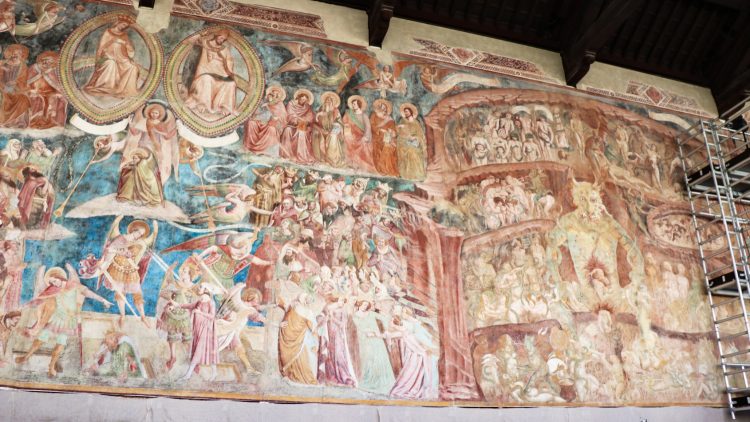
Arguably the most impressive cycle is among the oldest frescoes in the Camposanto (in the corner closest to the Duomo). It covers three main themes: the Triumph of Death, the Last Judgement, and Hell. These frescoes were painted by Francesco Traini and Bonamico Buffalmacco around 1340 and returned fully restored to the arcades in 2018.
Triumph of Death Fresco in the Camposanto in Pisa
The Triumph of Death was painted after the black plague hit Pisa. The locals were familiar with death coming unexpectedly and taking people away irrespective of class or age. The whole painting is a warning that death comes to everyone and often without warning.
Death flies almost serenely through the sky, scythe in hand. Where and who will it hit next? The party of young nobles enjoying life seemingly without a care under the orange trees? Death has already taken a pope, a king, a queen, a cardinal, a bishop, monks, and many more.
Somehow Death flying through the sky is not the scariest scene in the cycle. Death is inevitable, only the timing is uncertain. More frightening, and a clear message to the religious 14th century is the instant judgment at death. Angels and demons swiftly snatch away the souls of the dead, sometimes fighting in the sky over possession. The damned is fed straight into the fires of hell.
A famous scene is the royal procession that passes three coffins with bodies in different states of decomposition. A young knight points them out to the king, who holds his nose against the stench, while his horse seems to lean in for a sniff. The queen looks away distraught. Death comes to everyone, but earthly peace may be found by living the life of the monks (upper lefthand corner).
The Last Judgment and Hell Frescoes in Pisa
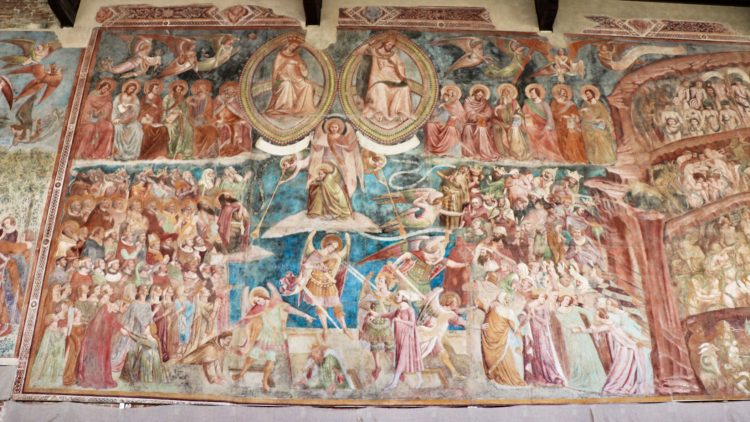
The Last Judgement follows the fairly conventional layout — Christ and the Madonna judging the resurrected. Once again, in death class offers no safety or distinction — there seems to be as many crowned heads among the condemned being pushed towards hell as amongst the saved destined for eternal life in heaven.
The scenes from Hell are powerful. This is straight from Dante’s Inferno. At the center is the triple-faced satan — devouring and excreting sinners at will. Devils in all shapes and forms torment the condemned without end. Scenes of fire and pain should shock the viewers into leading a God-fearing life.
Further Frescoes in the Camposanto in Pisa
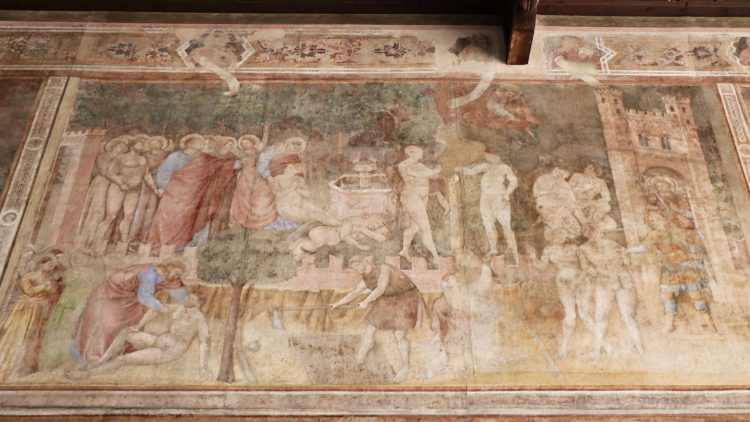
The cycle of frescoes containing the “Stories of Pisan Saints” by Andrea Bonaiuti, Antonio Veneziano, and Spinello Aretino is generally more peaceful.
The northern wall has scenes from the Old Testament, started by Taddeo Gaddi and Piero di Puccio and finished in the mid-15th century by the Florentine Benozzo Gozzoli. Background scenes, activities, and buildings show these as clearly newer works.
Some, such as the badly damaged burning of Sodom and Gomorrah show a single event while others play a whole cartoon story in a single frame. E.g. the paradise scene: it starts with the creation of man, Eva being made out of Adam, the snake and the apple (original sin), hiding from God, being chased out of paradise, and Adam working the fields while Eva is with a child.
Sarcophagi in the Camposanto
Although the frescoes are the main attraction of the Camposanto, the galleries have several further artworks including many sarcophagi and sculptures. The 84 sarcophagi are mostly Roman originals that were repurposed by the rich in later centuries.
Several sculptures are also on display in the arcades while the chapels have a variety of reliquaries. In one is the lamp that supposedly inspired Galileo. It was replaced in the cathedral by a larger one that is often wrongly referred to as the Galileo lamp, as Galileo had already published his pendulum theory a few years earlier.
Camposanto Cemetery Visitor’s Information
The frescoes of the Camposanto are absolutely worth seeing. It is also interesting to see the Sinopie Museum but it is highly advisable to visit that museum first and to spend more time at the cemetery with the colorful frescoes rather than the original drawings.
Admission to the Field of Miracles (Campo Dei Miracoli) in Pisa and the exterior of all buildings in the area is free and possible at all times.
Tickets are available for the following sights in Pisa:
Cathedral (Duomo) — admission is free but only per time slot ticket. Pick up a free pass in person only from any ticket office. On very busy days, there may be a delay in entering the church or occasionally, no more free tickets available on the day. However, any of the paid tickets below automatically acts as a skip-the-line entry ticket to the duomo on the same day.
Climbing the Leaning Tower (Torre) — €20 per time-slot reservation tickets only. A combination pass with all other sites is around €30.
Baptistery (Battistero) / Camposanto Cemetery / Museum of the Sinopias (Museo delle Sinopie) / Museo dell’ Opera del Duomo (cathedral museum) — €7 for any site or great value at €10 for all sights. (Note that the baptistery is being renovated and some sections may be closed off.)
Palazzo dell’ Opera del Duomo — admission depends on the exhibition, if any.
The two ticket offices at the Field of Miracles are inside the Sinopie Museum (near the Baptistery) and in the Palazzo dell’ Opera del Duomo (behind the church near the leaning tower).
Time-slot reservation tickets for the leaning tower of Pisa may be bought online at least a day in advance from Opapisa (tickets valid for a year so no refunds for any reason) or resellers such as Tiqets and Get Your Guide, which have much easier cancelation conditions. Opapisa sells tickets at most 20 days in advance while the resellers usually sell several months in advance. A variety of guided tours are available to see the sights on the Fields of Miracles of Pisa with many including climbing the leaning tower.
Opening Hours of Field of Miracles Sites in Pisa
The sights on the Field of Miracles in Pisa are open every day – exact times may be confirmed months in advance at the OpaPisa site.
All the sites are generally open as a minimum from 9:00 (10:00 for the Duomo) to 19:00. From April to September, the opening hours are usually 8:00 (10:00 for the Duomo) to 20:00 with the Camposanto and Tower open until 22:00 on some nights.
Last tickets are sold around half an hour before closing time (but expect an argument at the door if leaving it that late).
Combination tickets are valid for a year after the selected date so refunds are not given if a site is closed on a particular day(s).
More Information On Top Sights in Pisa
- See the Top Sights on Pisa’s Field of Miracles
- Tips on Buying Tickets and Tours for the Leaning Tower and Pisa Sights
- Visit the Duomo (Cathedral) of Pisa (Cattedrale)
- Visit the Baptistery of Pisa (Battistero)
- Visit the Cathedral Museum (Museo dell’ Opera del Duomo di Pisa)
- See Renaissance Frescoes in the Camposanto Cemetery
- Visit the Sinopie Museum in Pisa
- Transportation to the Leaning Tower of Pisa
- Book Guided Tours of Pisa and Day Trips at Get Your Guide
- Buy Tickets Online at Tiqets
- Book Italian Train and Intercity Bus Tickets at Omio
- More Photos of the Field of Miracles in Pisa on Flickr

